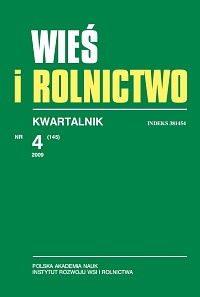Polska wieś czasu transformacji: mity i rzeczywistość
Polish Rural Community of the Transformation Period: Myths and Reality
Author(s): Izabella Bukraba-RylskaSubject(s): Social Sciences
Published by: Instytut Rozwoju Wsi i Rolnictwa Polskiej Akademii Nauk
Keywords: modernisation paradox; sociology’s anti-ruralism; inter-branch flows; deruralisation; disagrarisation; depeasantation; transformation/desolation; paradoks modernizacyjny; antyruralizm socjologii; przepływy międzygałęziowe; deruralizacja; dezagraryzacja
Summary/Abstract: The passing two decades have been characterised by far-reaching independence of scientific considerations from the real situation. The three main processes (deruralisation, disagrarisation and depeasantation), recognised as the key aspects of the continuing development of the rural community and agriculture, have been developing at a very slow pace or have been halted altogether. In addition, the parameters defining these processes are far worse now than they were at the close of the communist era. Thus, it is possible to claim that the so-called agrarian segment is subject to regression rather than development and that transformation means nothing else in the case of this segment than desolation. The suggested phenomenon can be considered as typical for the cycle of Polish modernisation reforms which have been characterised since the 15th century by the stigma of a “paradox”: rural community and agriculture serve as a shock-absorber of consecutive transformations, bearing the costs and negative consequences of these transformations. Mijające dwie dekady cechuje daleko posunięta niezależność naukowego myślenia od rzeczywistości. Trzy główne procesy (deruralizacja, dezagraryzacja i depezantyzacja), uznawane za najważniejsze wymiary dokonującej się transformacji wsi i rolnictwa, zachodzą bardzo powoli bądź w ogóle uległy wyhamowaniu, co więcej, wyrażające je parametry pozostają dużo gorsze niż u schyłku „komuny”. Można zatem zaryzykować twierdzenie, iż tzw. segment agrarny podlega nie rozwojowi, ale regresowi, a transformacja to w jego przypadku tyle, co dezolacja. Sugerowane zjawisko wpisuje się jako typowe w cykl polskich modernizacji, naznaczonych od XV wieku piętnem „paradoksu”: wieś i rolnictwo służą za amortyzator kolejnych przemian, ponosząc ich koszty i negatywne konsekwencje.
Journal: Wieś i Rolnictwo
- Issue Year: 145/2009
- Issue No: 4
- Page Range: 29-49
- Page Count: 21
- Language: Polish

